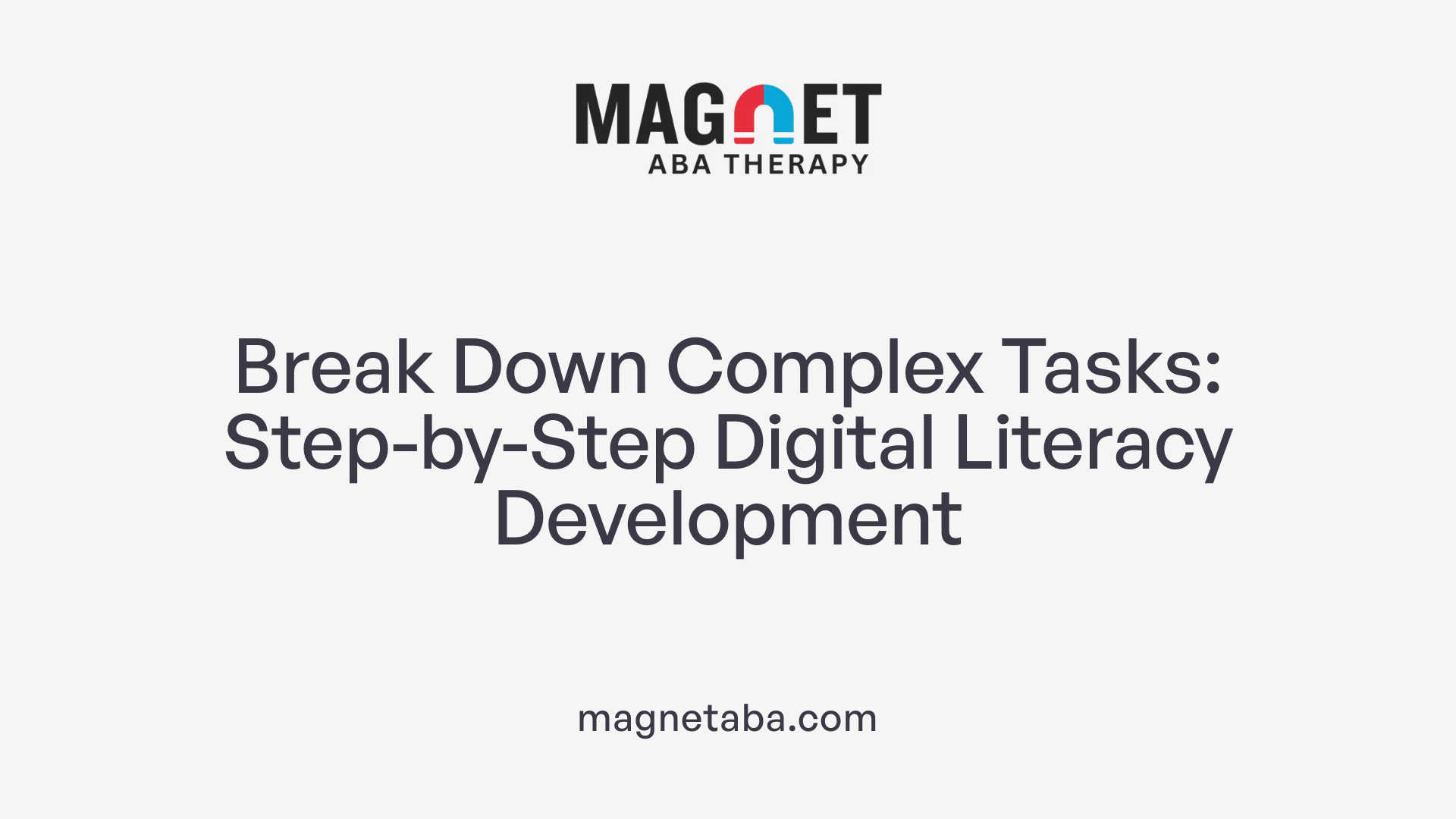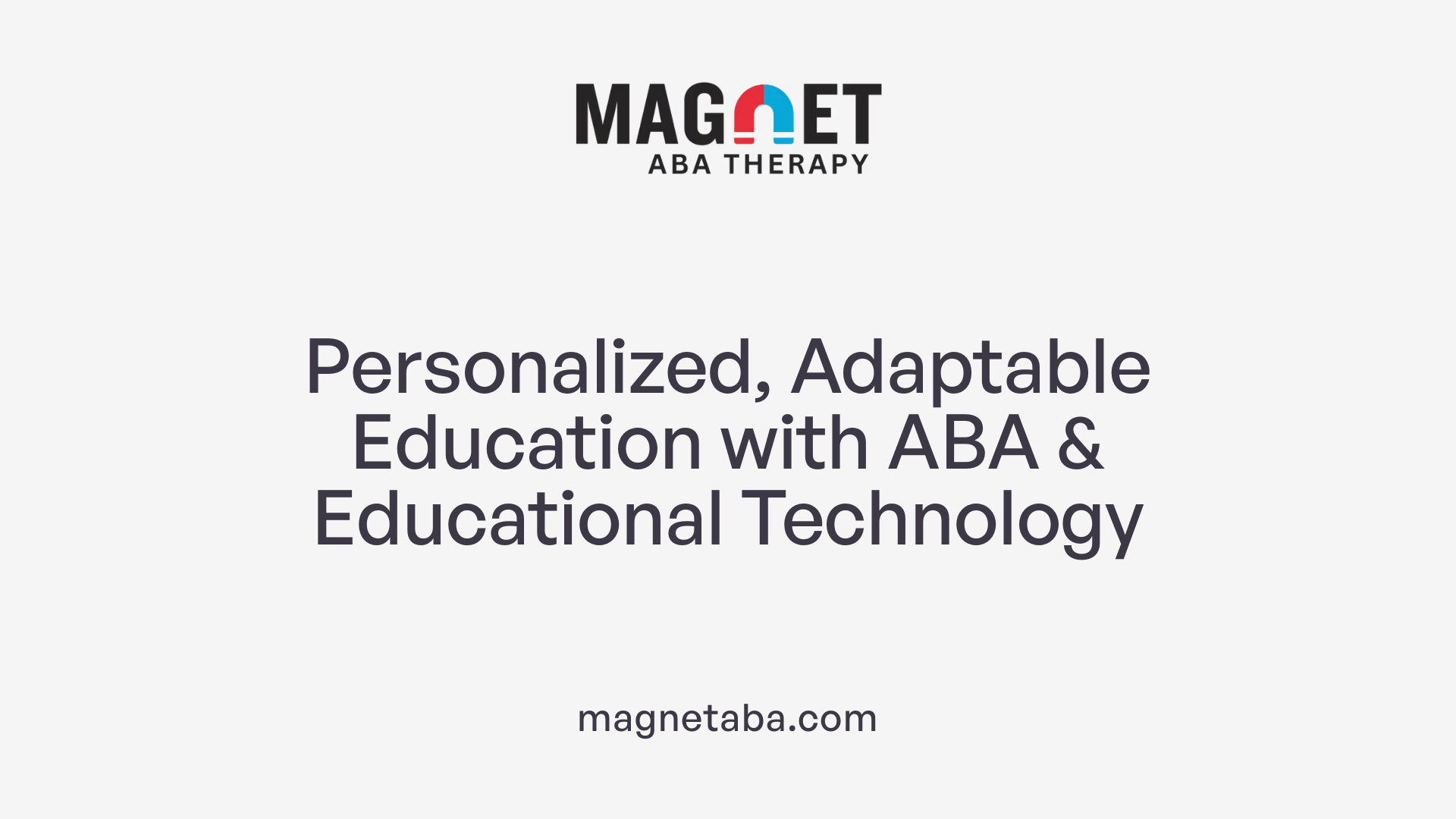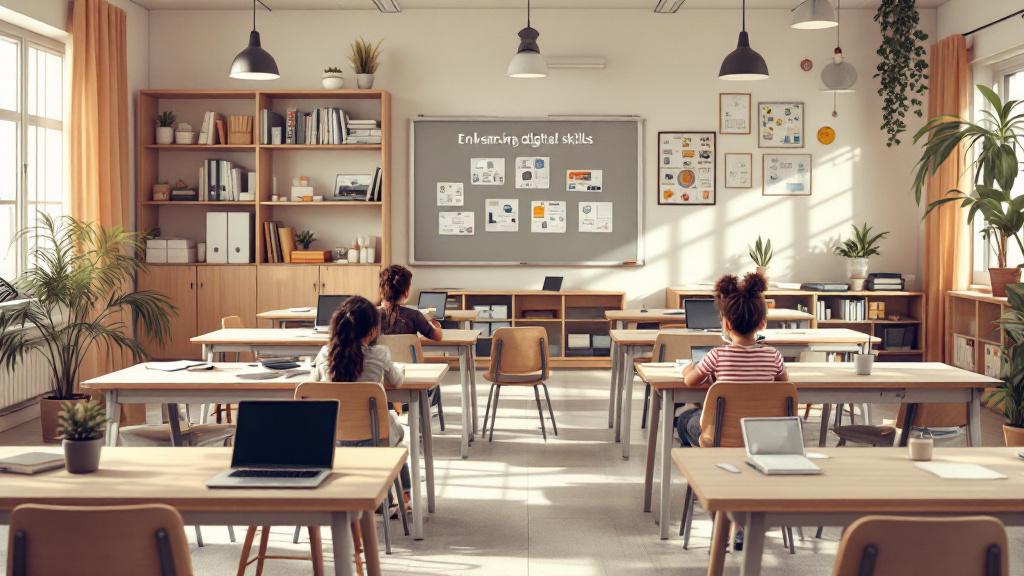Bridging Behavior Analysis and Digital Education
In today's digital age, integrating effective learning strategies with technology is essential for fostering digital literacy among diverse learners. Applied Behavior Analysis (ABA), with its structured and evidence-based approach, offers powerful tools to support this integration. This article explores how ABA can enhance digital literacy development, address online safety, and promote inclusive, engaging learning environments through innovative technological tools and methods.
Applying ABA in Digital Literacy Education

How does Applied Behavior Analysis (ABA) support the development of digital literacy skills?
Applied Behavior Analysis (ABA) is a structured and effective approach to teaching digital literacy skills, especially for learners who benefit from systematic instruction. ABA breaks down complex online tasks into smaller, manageable steps, ensuring that learners can master each component before moving on to the next. This method promotes gradual learning and reduces frustration.
Reinforcement plays a central role in ABA, where positive feedback encourages correct and safe online behaviors. For example, when a student successfully evaluates the credibility of a website or practices safe internet use, they are reinforced with praise, tokens, or other motivators. This consistent reinforcement helps solidify new skills and promotes responsible digital citizenship.
ABA techniques are adaptable to teach a variety of digital skills. These include online safety protocols, evaluating information sources critically, and practicing respectful and effective digital communication. The personalized nature of ABA allows strategies to be tailored to each individual's needs, making learning more effective.
Furthermore, ABA supports the development of problem-solving and critical thinking skills within digital environments. By providing opportunities for learners to practice scenarios that require decision-making and social interaction online, ABA helps build confidence and independence.
For learners with autism spectrum disorder (ASD) or other developmental differences, ABA offers a structured pathway to acquire essential digital skills. These skills are vital not only for academic success but also for social inclusion and participation in today’s increasingly digital world.
Overall, ABA provides a comprehensive framework that guides learners through the complexities of digital literacy in a clear, encouraging, and consistent manner. Its focus on positive reinforcement and skill mastery fosters independence, responsible internet use, and active participation in digital communities.
What are some technology-assisted ABA tools and methods that can enhance digital literacy?
Modern technology offers numerous tools to support ABA and enhance digital literacy education. Tablets and smartphones equipped with visual schedules, communication apps, and interactive games are excellent for teaching daily living skills and problem-solving in a fun, engaging way. These devices help learners practice digital tasks, such as navigating websites or using communication platforms, within a guided environment.
Virtual reality (VR) and augmented reality (AR) applications create immersive social scenarios, allowing children to practice social responses, emotional regulation, and digital interactions safely. For example, a VR program might simulate a social media setting, helping learners understand appropriate sharing and privacy behaviors.
Artificial Intelligence (AI) and adaptive technologies personalize learning experiences by modifying content based on real-time feedback. AI-driven systems can adjust the difficulty level and offer tailored prompts, increasing engagement and fostering independence in digital tasks.
Telehealth platforms enable remote ABA therapy sessions, making behavioral interventions accessible even in remote areas. These platforms also facilitate ongoing data collection and behavioral monitoring, ensuring interventions are tailored and responsive.
Robotic devices and wearable sensors further support behavior management by providing real-time data on physiological responses during digital interactions. For example, sensors tracking stress levels can inform caregivers or therapists about emotional states during online activities, guiding interventions.
Additionally, augmentative and alternative communication (AAC) devices and digital tools promote communication skills, which are fundamental to digital literacy. These platforms support expressive language, vocabulary development, and social communication.
In summary, a suite of advanced technological tools enhances the teaching and reinforcement of digital literacy skills through personalized, interactive, and accessible methods. Their integration with ABA strategies amplifies learning outcomes and prepares individuals for full participation in digital environments.
Implementing ABA in Online Learning Environments

How can ABA techniques be applied in online learning environments?
Applied Behavior Analysis (ABA) strategies translate effectively into the virtual realm by emphasizing structured routines, visual cues, and personalized goals. Digital tools such as visual aids, prompts, and interactive modules help reinforce positive behaviors and facilitate learning.
Incorporating technology like digital planners, speech-to-text applications, and virtual collaboration platforms encourages active participation and clear communication. These tools support learners in navigating their daily routines, setting achievable goals, and engaging meaningfully in their educational activities.
Creating a distraction-free space is essential. Minimizing sensory overload, providing flexible scheduling, and incorporating regular breaks help sustain attention and reduce fatigue. Engaging parents through monitoring tools and communication portals enables reinforcement of behaviors outside formal sessions.
Emerging advancements such as sensor-based data collection and AI-driven insights offer opportunities for personalizing interventions. These technologies monitor physiological responses and environmental factors, helping tailor strategies for optimal outcomes.
Overall, combining these elements ensures ABA techniques are adaptable to online platforms, promoting effective, engaging, and personalized learning experiences for individuals with behavioral support needs.
Supporting Inclusive Education with ABA and EdTech

How can ABA support inclusive education through integration with EdTech?
Applied Behavior Analysis (ABA) plays a vital role in fostering inclusive education by offering tailored strategies that enhance social, communication, and behavioral skills among students with diverse learning needs, including those on the autism spectrum.
When integrated with the latest educational technology (EdTech), ABA becomes significantly more effective and accessible. Digital tools such as real-time data collection platforms, interactive applications, and video conferencing enable educators and therapists to monitor student progress continuously and adjust interventions promptly.
For instance, platforms like digital portfolios and Google Sheets streamline the assessment process, store data securely, and facilitate collaborative planning among teachers, therapists, and parents. Interactive programs, including Boom™ Cards, elevate student engagement through fun, customizable activities that provide instant feedback. These tools not only reduce paperwork but also allow for the creation of highly individualized learning paths.
Technology also supports behavior management and communication through visual supports and positive reinforcement systems. Visual schedules, social stories, and reward charts can be shared digitally to foster understanding and encourage desirable behaviors.
Furthermore, virtual tools enhance communication with families and support staff. Video conferencing and real-time coaching enable consistent behavior strategies and parent training even from remote locations. This approach ensures that support for students can be maintained irrespective of physical classroom constraints.
Personalizing strategies for diverse learners
To ensure all students benefit, ABA strategies should be tailored to individual needs. ABA practitioners leverage EdTech tools to customize learning activities, adjust complexity levels, and incorporate preferred interests, making learning more engaging.
Real-time data collection and collaboration tools
Real-time data collection via digital platforms allows for immediate analysis, leading to faster decision-making. Collaborative tools like Google Forms and Sheets facilitate joint interventions, shared goal setting, and progress tracking, which are essential for inclusive classrooms.
Visual supports and positive reinforcement
Using visual aids—digital or physical—is crucial for supporting students with diverse learning styles. Visual supports help clarify expectations and reduce anxiety, while positive reinforcement encourages appropriate behaviors, strengthening learning and social interactions.
Impact of EdTech in inclusive settings
The blend of ABA and EdTech promotes an inclusive, dynamic learning environment. Students feel supported, understood, and motivated to participate actively. Teachers can better accommodate individual differences, ensuring that every learner has access to meaningful educational experiences.
| Aspect | Tools and Techniques | Benefits |
|---|---|---|
| Digital Assessment & Tracking | Google Sheets, Forms, BehaviorData Apps | Streamlined data collection, real-time analysis, shared progress updates |
| Engagement & Learning | Boom™ Cards, interactive apps, VR environments | Increased motivation, immediate feedback, practice of social skills in controlled settings |
| Communication & Support | Video conferencing, digital visual supports, parent portals | Enhanced communication, parent training, consistent strategies across home and school |
| Behavior Management | Digital reinforcement programs, visual schedules | Clear expectations, positive behavioral reinforcement, reduced behavioral disruptions |
In conclusion, combining ABA principles with innovative EdTech solutions creates a more inclusive, engaging, and responsive educational environment. This approach addresses the unique needs of each learner, promotes active participation, and fosters meaningful progress, making education a truly accessible experience for all students.
The Significance of Telehealth in Digital Literacy ABA Interventions
What role does telehealth play in delivering ABA services related to digital literacy?
Telehealth is transforming the delivery of ABA services, especially those targeting digital literacy skills. It enables practitioners to reach children and families regardless of their geographic location, making therapy more accessible. Through live video sessions, therapists can provide real-time coaching, demonstrate strategies, and observe children in natural settings, which is essential for generalizing new skills.
Digital tools integrated into telehealth platforms allow consistent tracking of progress and immediate feedback. This method supports dynamic assessments, enabling therapists to tailor interventions swiftly based on data collected during sessions. Moreover, parent training modules and interactive platforms shared via secure videoconferencing empower caregivers to implement ABA strategies confidently at home.
By focusing on natural environment skill transfer, telehealth ensures that children learn to use digital devices for communication and social interactions in everyday contexts. This approach enhances functional use and increases the likelihood of maintaining skills beyond therapy sessions.
How does telehealth improve access for remote and underserved populations?
One of the most significant benefits of telehealth is its ability to bridge gaps in service availability. Families living in rural or underserved areas often face barriers such as limited local providers, transportation challenges, and scheduling conflicts.
Virtual ABA services eliminate the need for travel, saving time and resources and providing greater flexibility in scheduling. This convenience encourages higher engagement levels and consistency in intervention delivery.
Studies show that virtual ABA therapists can achieve similar outcomes in improving communication, social skills, and reducing maladaptive behaviors as traditional in-clinic therapy. Satisfaction with telehealth services is high among families, with many reporting better access to continuous care.
How does telehealth support transferring skills to natural environments?
The natural environment is crucial for effectively teaching and maintaining digital literacy skills. Telehealth allows therapists to directly observe and guide parents and children in real-life settings, such as homes or community spaces.
By coaching parents through live video, therapists can model strategies for using tablets, apps, and communication devices during everyday activities. This close supervision and immediate feedback help ensure that learned skills are generalized and maintained in meaningful contexts.
Furthermore, technologies like VR and video modeling integrated into telehealth sessions simulate social scenarios, giving children safe, controlled opportunities to practice digital interactions.
Table Summarizing Telehealth Benefits in Digital Literacy ABA Interventions
| Benefit | Description | Impact |
|---|---|---|
| Accessibility | Reaches remote and underserved populations | Increases service coverage and consistency |
| Real-Time Support | Live coaching and immediate feedback in natural settings | Enhances skill transfer and generalization |
| Parent Involvement | Training and collaboration via video platforms | Reinforces skills at home and encourages independence |
| Use of Digital Tools | Incorporation of apps, VR, and video modeling in therapy | Promotes engagement and functional use of devices |
| Data Collection and Monitoring | Digital platforms allow real-time progress tracking | Facilitates adaptive interventions and goal adjustments |
Final Thoughts
Telehealth has become a vital component in ABA interventions focused on digital literacy. Its ability to deliver services remotely, support natural environment skill transfer, and involve families directly makes it a versatile and effective tool, especially for children with ASD. As technology continues to evolve, so will the opportunities for innovative ABA strategies that improve outcomes and expand access for families worldwide.
Using AAC and Visual Schedules to Foster Digital Literacy

How are tools like AAC devices and visual schedules used in ABA to improve digital literacy?
Augmentative and Alternative Communication (AAC) devices, along with visual schedules, play a vital role in ABA therapy to support and enhance digital literacy skills. These tools help individuals with limited verbal communication abilities to participate more fully in digital environments, fostering independence and social engagement.
AAC devices include speech-generating devices and communication apps on tablets or smartphones. They enable users to express their needs, participate in conversations, and follow instructions related to technology use. For instance, a child might use an AAC app to select words or images that communicate a desire to play a game or ask for help with a device. This functionality helps improve their confidence and competence in navigating digital tools.
Visual schedules and social stories provide structured routines and predictable sequences of steps for using technology. They help individuals understand what to expect during digital activities, such as turning on a device, opening an app, or following steps to complete an online task. By establishing clear expectations and routines, visual supports reduce anxiety and increase engagement.
These tools actively promote independence by teaching appropriate ways to respond, behave, and interact in digital settings. For example, a visual schedule might illustrate the steps needed to log into an educational platform or join a video call, helping users learn to manage digital interactions independently.
Personalization is essential — supports are tailored to individual needs, considering their communication abilities and specific challenges. When integrated effectively, AAC devices and visual schedules not only enhance communication but also lay the foundation for acquiring digital literacy skills within ABA therapy frameworks.
Routine understanding and structure
Implementing visual schedules helps individuals grasp routines involving technology, such as scheduled online sessions or digital breaks. Establishing clear, visual routines fosters a sense of control and predictability, which is crucial when navigating digital literacy tasks.
Promoting independence in digital environments
Both AAC and visual supports empower individuals to use digital tools independently, whether by following steps on a schedule, requesting assistance, or engaging in online learning activities. This independence transfer is vital for developing functional digital literacy skills essential in today's digital age.
In summary, integrating AAC devices and visual schedules within ABA therapy effectively improves individuals' communication capabilities, understanding of routines, and independence in digital settings. This comprehensive approach supports learners in becoming confident and competent users of technology, an increasingly important aspect of modern education and daily life.
Promoting Online Safety and Responsible Behavior through ABA
How can ABA promote internet safety and appropriate online behavior?
Applied Behavior Analysis (ABA) offers effective strategies to teach digital safety and foster responsible online conduct, especially among young adults with autism. Using structured, evidence-based methods, ABA programs incorporate modeling, reinforcement, and repeated practice to help individuals develop essential skills for navigating the digital world.
One core focus of ABA in this area is teaching the fundamentals of cybersecurity, such as creating and maintaining strong passwords, avoiding scams, and safeguarding personal information. These skills are taught through direct demonstration and positive reinforcement when correct behaviors are exhibited, encouraging learners to internalize safe habits.
In addition to technical safety measures, ABA addresses social aspects of online behavior. This includes guidance on interacting appropriately on social media, recognizing and responding to cyberbullying, and avoiding risky online interactions. Role-playing scenarios and video modeling are often used to illustrate acceptable behavior and help learners practice these skills in a safe, controlled setting.
Reinforcement strategies play a vital role in ingraining responsible online habits. When learners correctly apply safety and social norms, they receive praise, tokens, or other rewards that motivate continued adherence.
Furthermore, ABA emphasizes the importance of fostering good judgment in the digital domain. Through ongoing assessments and individualized plans, practitioners tailor interventions that build confidence and independence in managing online interactions.
With the increasing importance of digital literacy, ABA programs also include education on digital citizenship—teaching individuals about respectful communication, digital etiquette, and the long-term impacts of online behavior. This comprehensive approach ensures that young adults are equipped not only to stay safe but also to participate positively in online communities.
Overall, ABA provides a structured and effective framework to develop responsible digital behaviors, helping individuals navigate the internet confidently, securely, and respectfully.
Educational Benefits and Future Directions of ABA in Digital Literacy
How does ABA support personalized learning and student engagement in digital literacy?
Applied Behavior Analysis (ABA) plays a vital role in creating personalized educational experiences, especially when fostering digital literacy skills among students with diverse needs. By tailoring instruction to a student’s individual preferences, sensory sensitivities, and learning pace, ABA techniques enhance engagement and motivation.
Digital platforms designed with ABA principles often include reward systems like virtual tokens, badges, or positive feedback, which reinforce successful interactions and learning behaviors. These immediate reinforcements help sustain attention and encourage the consistent practice of new skills.
Structured routines embedded in educational apps, such as visual schedules or timers, provide predictability and help students feel secure as they navigate digital environments. This routine consistency supports skill retention and independence, making learning both predictable and accessible.
What's the role of real-time progress monitoring in ABA-based digital literacy programs?
Real-time data collection is a cornerstone of ABA and vital for effective digital literacy instruction. Technology allows educators, therapists, and parents to track each student’s progress with precision, using digital tools like assessment software and learning management systems.
These tools enable immediate feedback about what skills are being acquired, what behaviors need support, and whether teaching strategies are effective. Data dashboards visualize progress trends over time, allowing educators to quickly adapt lesson plans, reinforce successful strategies, and address challenges promptly. This dynamic approach maximizes learning outcomes and promotes continuous improvement.
How can digital literacy programs create inclusive and adaptive learning environments?
Digital tools supported by ABA principles foster inclusive environments where students of varying abilities can thrive. Adaptive learning technologies respond to individual student needs by adjusting content difficulty, presentation style, and pacing.
For example, interactive apps like Boom™ Cards provide customizable experiences that increase engagement while accommodating different learning styles. These tools often include options for visual, auditory, and kinesthetic learners, ensuring accessibility for a broad range of students.
In addition, collaborative platforms such as Google Sheets and Forms facilitate team-based planning and data sharing among educators, therapists, and families. This collaboration ensures consistent, culturally responsive, and personalized support, enabling all students to participate actively and benefit from instruction.
What are the educational advantages of integrating ABA with technology in schools?
Implementing ABA with educational technology enhances several aspects of learning. Digital tools enable precise data collection and analysis, which inform tailored instruction and targeted interventions.
Real-time progress tracking helps educators respond swiftly to student needs, adjusting teaching methods or routines as required. Virtual interactions, including video modeling and telehealth sessions, provide safe and effective ways for students to practice social and communication skills outside of traditional settings.
Moreover, technology encourages active participation through gamified learning, instant feedback, and engaging multimedia content. These features make lessons more appealing and accessible, especially for students with autism or other special needs.
How is telehealth transforming ABA therapy and what are its benefits?
Telehealth has revolutionized ABA therapy by making services more accessible and flexible. Supported by research and widespread practice, virtual ABA sessions involve live video coaching for parents and direct engagement with children.
Studies indicate that remote ABA produces similar improvements in communication, social skills, and behavior reduction compared to in-person therapy. Satisfaction rates among families reach around 90%, highlighting its effectiveness.
This modality allows children in remote or underserved areas to receive consistent therapy, reduces travel burdens, and offers scheduling flexibility. Telehealth also promotes natural skill transfer by enabling practice in the child’s home environment, which can lead to better generalization of skills.
How do digital and wearable tools enhance ABA interventions?
Technological advancements extend ABA beyond traditional methods. Wearable devices that monitor physiological data, such as heart rate or stress levels, provide deeper insights into a child's emotional states during therapy, allowing for more tailored interventions.
Educational apps and virtual reality environments create controlled social scenarios for practicing communication and social skills. Video modeling helps children imitate appropriate behaviors within engaging contexts.
All digital tools used in ABA should be personalized to each child's specific needs and should complement real-world interactions. Moreover, adherence to data security standards is crucial to protect sensitive information.
Future opportunities for ABA and digital literacy?
The future of ABA in education involves integrating technology more deeply into daily learning. Advancements in artificial intelligence and machine learning may enable even more personalized instruction and automated progress analysis.
Expanding virtual reality scenarios could provide immersive social skills practice, increasingly mimicking real-life interactions. Wearable sensors could offer continuous emotional and physiological monitoring, informing real-time adjustments.
As these technologies evolve, ensuring accessibility, data security, and cultural responsiveness will be essential. The goal remains to create inclusive, engaging, and effective learning environments that support all learners.
| Aspect | Description | Examples |
|---|---|---|
| Personalized Learning | Tailoring instruction to individual needs and preferences | Visual schedules, reward systems, sensory adjustments |
| Progress Monitoring | Tracking and responding to data in real-time | Digital dashboards, assessment software |
| Inclusive Environments | Supporting diverse learners with adaptive tech | Boom! Cards, Google tools, customizable content |
| Telehealth Applications | Remote therapy services with live coaching | Video sessions, parent training modules |
| Future Innovations | Emerging technologies enhancing ABA practice | VR social scenarios, AI-driven analytics |
Incorporating ABA with digital tools fosters engaging, adaptable, and inclusive learning environments. Its implementation boosts social, communication, and technical skills, preparing students for a broader range of challenges and opportunities.
Shaping a Digital Future with Behavioral Strategies
Integrating ABA techniques with innovative digital tools offers promising pathways to develop essential digital literacy skills across diverse learner populations. This structured, engaging, and personalized approach not only enhances learning outcomes but also prepares individuals to navigate the complexities of the digital world safely and responsibly. As telehealth, AI, VR, and EdTech continue to evolve, their synergy with ABA will further expand access, inclusivity, and effectiveness in digital education. Embracing these advancements will support lifelong learning, foster digital citizenship, and ultimately empower learners to thrive in an increasingly connected society.
References
- ABA Technologies Leads Forward with Digital Learning
- The Role of Technology in ABA Therapy
- Integrating EdTech and Interactive Tools in Special Education ...
- ABA Therapy Telehealth - Ultimate Guide - Forta Health
- Internet Safety Skills Program - ABA Behavioral Consulting
- [PDF] ONLINE SAFETY FOR TEENS AND ADULTS WITH ASD
- ABA Therapy Telehealth - Ultimate Guide - Forta Health
- The impact of a telehealth platform on ABA-based parent training ...
- Maximizing Patient Outcomes: The Rising Potential of Telehealth ...












